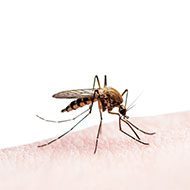Culex Mosquito
Color varies, mostly gray with white or silver, or bronze, blue-green scales; narrow, oval shape; 1/4 – 3/8 of an inch in length.

Diet: To feed, culex mosquitoes detect body heat and carbon dioxide that is exhaled when we breathe. Since mosquitoes need blood to produce eggs, females will feed on blood from humans and animals while males feed on plant nectars. It can take several days to digest blood, at which point the females will seek out a body of stagnant water to lay eggs.
Habitat: Culex mosquitoes prefer warm, wet environments and surface-level habitats of stagnant water, including ponds, marshes, floodwaters, pastures, and even old tires or tree stumps. They do not feed in the same location that they habitat—they rest in forests and woodlands during the day, but seek out open land during dusk and night to feed.
Threats: The result of a mosquito bite is typically an itchy bump or welt that occurs due to the body reacting to the mosquito’s saliva, which is injected into the skin to keep blood from clotting while they feed, and allows them to consume blood quickly before the host notices. West Nile virus is one of the known diseases that can be transmitted.
Control: Begin with eliminating areas of standing water around the property such as flower pots, birdbaths, grill covers, or baby pools. Screen in all windows and doors and ensure they are well sealed so there are no tiny holes for entry. For other mosquito control, consider minimizing outside activity between dusk and dawn when mosquitoes are most active. If you are outside during those times of day, use insect repellent on exposed skin or wear loose long sleeves and pants.
